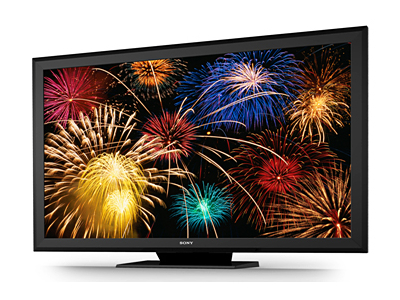Sony Intros 55-Inch Crystal LED Display Using 6 Million LEDs
Sony has developed a new Full HD display using six million LEDs and measuring 55-inches.

On Tuesday Sony said that it has developed the industry's first 55-inch Full HD self-emitting display using LEDs as the light source. Called the Crystal LED Display, it uses Sony’s "unique methods" to mount ultrafine LEDs in each of the Red-Green-Blue (RGB) colors, equivalent to the number of pixels -- meaning the company uses approximately six-million LEDs to create a Full HD display.
"The RGB LED light source is mounted directly on the front of the display, dramatically improving the light use efficiency," Sony said. "This results in images with strikingly higher contrast (in both light and dark environments), wider color gamut, superb video image response time, and wider viewing angles when compared to existing LCD and plasma displays, with low power consumption. Furthermore, due to the display’s structure, the “Crystal LED Display” is also ideal for large screens."
Sony is currently showing a prototype display at CES 2012 in Las Vegas. It has a brightness of approximately 400 cd/m², a viewing angle of approximately 180 degrees, and a contrast of "more than measurable limit values." The color gamut is also "more than 100-percent compared to NTSC (xy)." When compared to existing LCD displays from Sony, the prototype boasts approximately 3.5 times higher contrast in light environment, approximately 1.4 times wider color gamut, and approximately 10 times faster video image response time.
Sony said it will "work conscientiously" to bring the Crystal LED Display to market while also continuing development and commercialization of organic light emitting diode (OLED) displays.
Get Tom's Hardware's best news and in-depth reviews, straight to your inbox.
-
stellato12 First!...... but on topic, has "a contrast of more than measurable limit values." Geez!Reply -
soo-nah-mee This is what I thought current "LED" TVs were when they first came out. I was disappointed to find out that they were just referring to the backlighting.Reply
It sounds incredibly expensive to manufacture, but it must look amazing. -
willard Isn't Sony also fond of claiming infinite contrast ratios by turning the screen off completely to get their black value? I'm sure this screen is awesome, but I really don't trust Sony on their contrast ratio claims any more.Reply -
DeViLzzz2007 Hopefully unlike OLED oxygen doesn't kill it and also hopefully it has a life cycle longer than 7 years.Reply -
td854 IndignantSkepticso how does this compare to OLED?Reply
I'm interested in this, as well as knowing how much power draw is behind 6 million LEDs on a mostly white screen.
soo-nah-meeThis is what I thought current "LED" TVs were when they first came out. I was disappointed to find out that they were just referring to the backlighting.
same here -
Branden willard, the whole point of LED backlighting is to get deep blacks by turning backlighting off, as opposed to CCFL backlighting that is always on. it's not just sony that can erroneously brag about contrast ratios on their LED TVs, it's everyone who makes LED TVs.Reply
with that said, i understand the benefits of having the pixels themselves light up and negating backlighting altogether. it would actually improve contrast ratios, energy efficiency, and (i imagine) eliminate the "ghosting" effect current LED TVs suffer from while still maintaining the ability to deliver truly deep blacks.
i'd like to know pricing and availability on these TVs, i'll be in the market for a new HDTV in a year or two. -
megiv The example picture of the screen is pretty absurd, I mean, If it looks great, then the only reason is cuz my current screen got great colors.....Reply -
shoelessinsight willardIsn't Sony also fond of claiming infinite contrast ratios by turning the screen off completely to get their black value? I'm sure this screen is awesome, but I really don't trust Sony on their contrast ratio claims any more.Normally I would agree with you, as I am NOT a fan of dynamic contrast screens. Turning off sections of back lighting to boost contrast numbers does not increase the quality of the picture, and it creates halo effects when areas of light are surrounded by dark picture. It looks worse than when the dynamic lighting is disabled, in my opinion.Reply
However, in this case, I think the dynamic back lighting has real potential and the inflated numbers may finally be accurate. This screen would no longer be manipulating the back lighting for sections of the picture, but for each individual color of each individual pixel. This potentially puts the LCD picture on par, if not ahead, with what modern plasma screens are capable of, with much lower power use and waste heat.
I'm looking forward to this making its way into the mainstream. It's a technology approach that I always dreamed would happen but never dared to hope for. -
Au_equus Organic LEDs are based on organic compounds which may or may not have metals and, like devilzzz2007 pointed out, they break down over time (not to oxygen though these are sealed in a vacuum) due to electrical current and the resulting heat. these leds are more likely made of metals and metal compounds with nitrogen or various metalloids.Reply